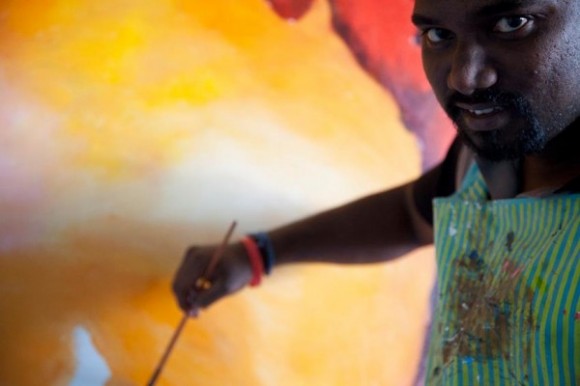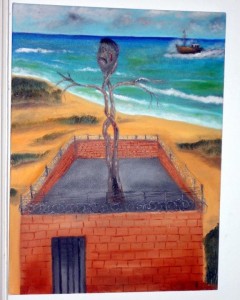They say a picture paints a thousand words.
But as I fixed my gaze upon Kamalesh’s harrowing oil painting, I began to wonder whether the age-old idiom did this work enough justice, writes Anusha Menon.
We’d talked about his time at Villawood Immigration Detention Centre plenty of times before. Yet, nothing he had previously told me quite articulated the grimness of life in mandatory detention as vividly as this painting did.
This picture didn’t just paint a thousand words. It spoke infinite, unutterable words of pain and torture.
Kamalesh, a Sri Lankan refugee who spent more than two years detained at Villawood IDC, was eventually granted his visa in September 2011. The artwork, which he describes as “refugee feeling,” was painted while he was still in detention.
I asked him how long he’d been painting, to which he replied: “Before detention, I had not painted.”
I knew he must have been pulling my leg. The quality of his work clearly attested to a lifetime of marking art.
But from his serious tone of voice, I knew he wasn’t lying.
“I learned how to paint from the TVS program Masterclass in Oils with Ken Harris. He is my master,” he said with a chuckle. “When I was in detention, I never missed that show.”
But to create paintings with such intricacy and depth, he needed specific brushes and oil paints.
Detainees held in Villawood IDC are rarely permitted beyond the centre premises. It would have been impossible for Kamalesh to go shopping for resources.
While Ken Harris taught Kamalesh the very basic skills required in landscape painting, it was the volunteers at The Refugee Art Project that provided him with most of the necessary materials he needed to make his art, and gave him the encouragement and professional guidance he needed to hone his skills.
“One of the most fulfilling parts of this project is seeing detainees enjoy themselves in art, and then develop their own creative vision and style in spite of the many burdens and constraints that are placed upon them. This was the case with Kamalesh,” said Dr Safdar Ahmed, founder and director of the project.
The Refugee Art Project began in late 2010 as an initiative to provide art classes for asylum seekers in detention and to showcase their creative work in public exhibitions. More than one year later, the project remains in full swing.
According to the project’s website, most of the artworks done by detainees share the same themes of trauma, exile, hope and endurance.
The project’s key intention is to express the stories and experiences of refugees in a manner that fruitfully engages with the general public.
“While refugee supporters do essential and valuable work, it occurred to us that asylum seekers are too often being spoken for or about, with little room to speak for themselves. Thus, our idea was to empower refugees by giving them a voice through art to the wider community,” said Dr Ahmed.
Villawood detention centre holds asylum seekers from different parts of the world. Not all of them have a good grasp of English, let alone a basic understanding of it. Art gives everyone the equal opportunity to speak their minds without having to use actual words.
“I was able to express my feelings through painting,” said Kamalesh. “Whatever materials I needed, I asked Safdar and he brought them in for me.”
An aspect of Kamalesh’s artwork that I found particularly striking was the tears of blood seeping from the hollowed eyes of the eerie humanoid tree in the central foreground of the painting.
When I asked Kamalesh what these bloody tears meant, he said: “Great sadness.”
I asked if the contorted figure was meant to be him. He smiled and shook his head. “No. It can be any refugee that is suffering from being in detention for such a long time.”
On March 30, a parliamentary inquiry into mandatory detention confirmed that 90 per cent of detainees suffer clinically significant depression. The report also stated that half this number is diagnosed with post-traumatic stress disorder and a quarter report having suicidal thoughts.
I asked Dr Ahmed about the impacts that the project has had on the mental health of detainees at Villawood.
“The act of art-making certainly provides a point of immersion during which detainees can forget about their problems, so it is therapeutic in that way,” he said.
Kamalesh agreed. “When I was inside my room, I would always feel tension. But when I attended the art classes in the visitor’s area, I was able to mix with different people and do painting. This made my mind feel relaxed.”
But Dr Ahmed made it clear that art therapy cannot significantly improve the symptoms of mental illness.
“We don’t see much chance of really helping people until they are taken out of the environment that is making them sick in the first place, which is the detention centre,” he said.
Nonetheless, the momentary solace and enjoyment that Kamalesh found when he mindfully engaged in painting was one of the most memorable parts of his time in detention. In fact, he and other detainees who also participated in the art classes and have since been granted visas, continue to maintain links with the project.
Some have even had the rewarding opportunity to see their own artworks publicly displayed.
Recently, the project hosted the highly successful Life in Limbo exhibition at The Braemer Gallery in the Blue Mountains. The exhibition, which contains a series of works produced entirely by asylum seekers, will also be displayed in Sydney’s UTS building throughout July and will tour to Melbourne in early October.
Dr Ahmed believes that the presentation of these artworks will have a positive impact on the Australian public.
“We are hoping to attract lots of people to the exhibition and open their eyes to the inspiring talent, perseverance and promise of those so unfairly locked away in our detention centres,” he said.
“The work in this exhibition shows the tenacity, hope and faith of people who have fled the most hellish circumstances to try and forge a new life for themselves and their families, and they should be admired and supported for that.”



